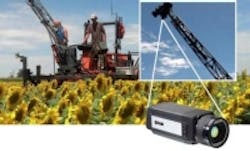Infrared camera helps monitor crops and measure water stress
Researchers from the US Department of Agriculture (USDA) are utilizing infrared imaging technology in order to monitor water stress on crops as part of the Water Management research program.
MORE ARTICLES
Infrared cameras provide unique look at F1 racing cars burning rubber
(Slideshow) Six different ways infrared imaging technology is being used
In the program, the USDA is seeking ways for farmers to be more productive by using less water. The researchers are imposing stress on crops and monitoring the stress. As a crop becomes water stressed, the leaves will start to curl and transpiration will decrease leading to an increase in leaf temperature. The ultimate goal of the program is to be more productive and find alternative ways of irrigation management. Previously, the USDA had used infrared thermometers for this task, but since these do not produce an image, the technique was limiting.
In order to provide images of the water-stressed crops, the USDA developed an imaging system that consists of a FLIR A655sc infrared camera, as well as an RGB camera, an IR thermometer, a multispectral camera, and a GPS. This equipment is attached to a boom and is mounted on a tractor. With the A655sc camera, the researchers are able to clearly separate plant temperature and ground temperature and see the difference between shaded leaves and non-shaded leaves. The camera features a 640 x 480 uncooled microbolometer infrared detector with a 17 µm pixel size and a spectral range of 7.5 to 14 µm. In addition, the camera is equipped with a GigE interface and provides 14-bit data at up to 50 fps at full resolution.
"We are very satisfied with the image quality of the FLIR A655sc. In our thermal images of sunflowers, we can clearly see the flower head that is hotter and the leaves that are 5 degrees colder," said a USDA spokesperson. “But also more in detail, we can see that the veins of the leaf are hotter than the rest of the leaf. This is highly quantitative data."
The spokesperson added "The FLIR camera has also proven to be very robust. While we are driving our tractor mounted thermal imaging set-up through the test fields, it can be hot and dusty sometimes, but the camera has done very well throughout our period of use. "
View the FLIR case study.
Share your vision-related news by contacting James Carroll, Senior Web Editor, Vision Systems Design
To receive news like this in your inbox, click here.
Join our LinkedIn group | Like us on Facebook | Follow us on Twitter | Check us out on Google +
About the Author

James Carroll
Former VSD Editor James Carroll joined the team 2013. Carroll covered machine vision and imaging from numerous angles, including application stories, industry news, market updates, and new products. In addition to writing and editing articles, Carroll managed the Innovators Awards program and webcasts.
